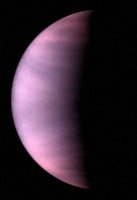|
|
Venus2004.org
> Files
2°) Mysterious Venus
Much of our knowledge of Venus itself has come from just five observations of the transit of the planet. During the 1761 transit, Lomonosov used a telescope to observe that Venus had an atmosphere. But although Venus is very similar to Earth in size and mass, it has evolved in a radically different manner, with a surface temperature hotter than a kitchen oven and a choking mixture of noxious gases for an atmosphere. Hurricane force winds permanently encircle the planet, and it has a very weak magnetic field.  Venus in ultraviolet light © ESA In the past, both the Russians and Americans have sent spacecraft to Venus. As the closest planet to the Earth, it was a natural target. These studies revealed details about the surface of the planet but Venus has been out of the limelight during the last decade, despite several scientific puzzles remaining. For example, what are the characteristics of the atmosphere? How does it circulate? How does the composition of the atmosphere change with depth? How does the atmosphere interact with the surface? How does the upper atmosphere interact with the solar wind? Why Venus rotates backwards and so slowly? |
|
© 2003-2006 Futura-Sciences.com. All rights reserved.
Indexator - Comparateur de prix - Revue de Presse
